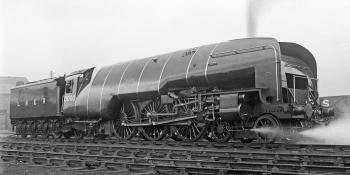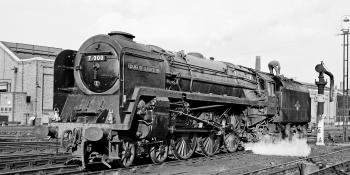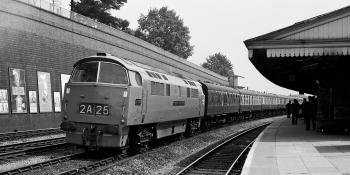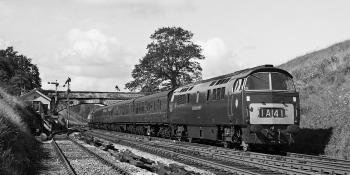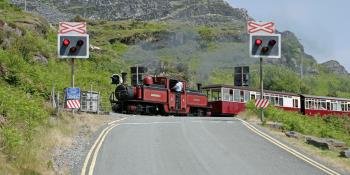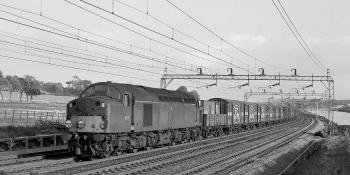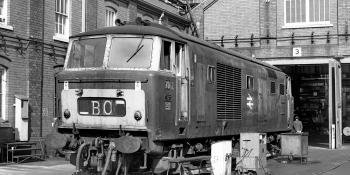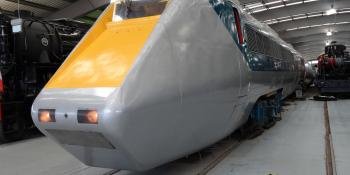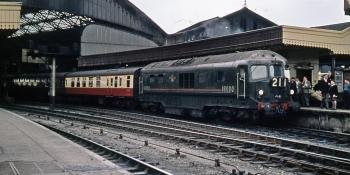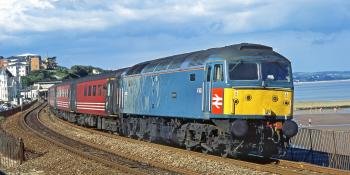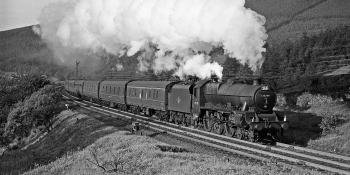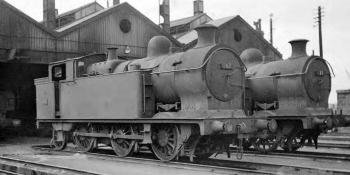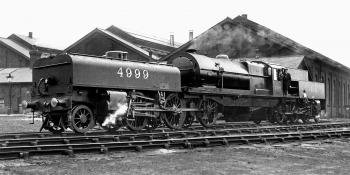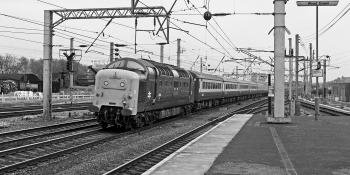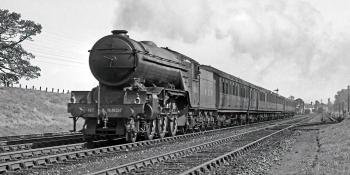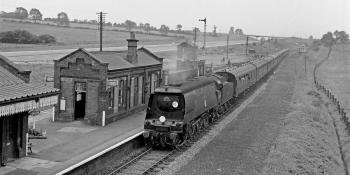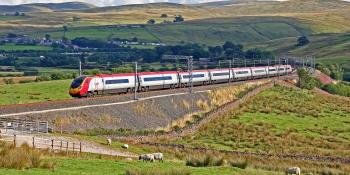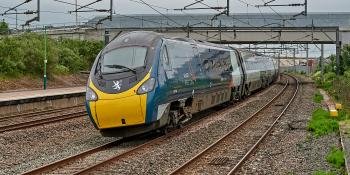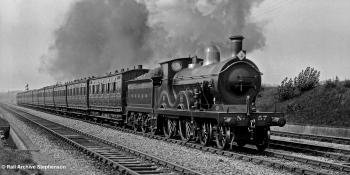RAILWAY HISTORY
Join us and delve into the archives to discover the stories of locomotive classes large and small, learn how the railway worked, and why it was built in this amalgamation of the popular Reality Check and Railway Realism sections from Hornby Magazine.
Gresley’s experimental ‘Hush-Hush'
In the quest for ever more efficient steam engines there have been some remarkable designs produced, some of which have been more successful than others. One of those that showed great promise, yet which failed to deliver, was the LNER’s ‘Hush-Hush’ 10000, as EVAN GREEN-HUGHES explains.
Races to the North
Victorian era saw intense competition between rival companies for traffic between London and Scotland, which reached its zenith in a thrilling series of events that were to become known as the ‘Railway Races to the North’. EVAN GREEN-HUGHES relays the fascinating story from a forgotten era of rail travel.
BR’s unique ‘Pacific’ Duke of Gloucester
Although it was a failure in service and lasted a mere eight years with BR, Duke of Gloucester has been transformed into a phenomenally powerful masterpiece in its preservation career. EVAN GREEN-HUGHES looks back at the history of this remarkable, and unique, engine.
Railhead Treatment Trains
While leaves on the line have become a regular topic for those who wish to make fun of our railways, for train operators they represent a very real danger and one that has demanded the introduction of special counter measures, which include the Rail Head Treatment Train, as EVAN GREEN-HUGHES describes.
Gresley's 'P2' 2-8-2
One of the most spectacular designs of the steam era was Gresley’s huge semi-streamlined express ‘P2’ 2-8-2. However due to mechanical problems these locomotives never realised their full potential and saw less than 10 years service before they were extensively rebuilt, as EVAN GREEN-HUGHES explains.
The ‘Western’ diesel hydraulics
One of the most distinctive locomotives of the early modernisation era was the ‘Western’ diesel-hydraulic, a design which had a very short life on the main line and which was rendered obsolete almost as soon as it was built, as EVAN GREEN-HUGHES reveals.
British Railways’ War of the diesels
One of British Railways most controversial decisions was to standardise on electric, rather than hydraulic transmission for diesel locomotives. EVAN GREEN-HUGHES looks at the background to this choice and and assesses whether it was correct.
Reality Check: The Double Fairlie
One of the most remarkable and recognisable locomotive designs of the Victorian era is the narrow gauge Double Fairlie, a type that became inexorably linked with the development of the Ffestiniog Railway in North Wales, but which also became world famous due to its incredible pulling power, as EVAN GREEN-HUGHES describes.
Reality Check: 'Whistler' magic
It is hard to believe that 50 years have passed since the first of British Railways’ large diesel locomotives were introduced. The English Electric Type 4, or Class 40 as it later became, was one of the success stories of the modernisation plan. EVAN GREEN-HUGHES looks back at the design’s history.
SWINDON WORKS
Swindon was amongst the railway towns and cities established in the 19th century. Its works came to personify efficiency and quality, a reputation lasting well into the diesel era. EVAN GREEN-HUGHES takes a look at this famous location and discovers how it came to occupy such an important pa rt in railway history.
BRUNEL’S ‘BILLIARD TABLE’
Designed for speeds higher than ever envisaged by the Victorias, the Great Western Main Line from London Paddington to Bristol via Reading and Swindon has been continually updated since its construction. EVAN GREEN-HUGHES relates how this carefully engineered railway has gone from a broad gauge steam operated line to one which features state-of-the-art Hitachi Class 800 bi-mode trains.
Reality Check: The Advanced Passenger Train - Experimental
One of the most revolutionary trains ever to take to the rails in the UK was the Advanced Passenger Train – Experimental, which was taken out of service 40 years ago this year. EVAN GREEN-HUGHES looks at the development of this pioneering machine.
The first gas turbine
Designers have been down many blind alleys in the pursuit of greater power, speed and efficiency. The Great Western Railway’s efforts to apply the gas turbine to rail were amongst them. EVAN GREEN-HUGHES describes the ups and downs of 18000, the first locomotive that resulted from this experiment.
The Brush Type 4 – the first 10 years
The Brush Type 4 celebrates its 60th anniversary in 2022 and remains one of the most popular and successful locomotives ever, as EVAN GREEN-HUGHES describes.
The eclectic Class 47s
Once British Railways most common mixed-traffic diesel, the Class 47s all looked much the same on the outside - but in fact there were many variations. EVAN GREEN-HUGHES explains all.
London Midland Region history
Of all the regions formed after the railways were nationalised in 1948, the London Midland was one of the largest, and most important, and greatly influenced the way that the country’s railways developed, as EVAN GREEN-HUGHES explains.
Railways of South Wales
In just over 200 years, the South Wales Valleys have gone from being the birthplace of railways, through housing one of the most intense freight systems in the world to becoming the home of a suburban commuter railway system. EVAN GREEN-HUGHES takes a look at this fascinating area, which is bristling with modelling possibilities.
The LMS Beyer-Garratts
The massive Beyer-Garratt articulated locomotives achieved a fair amount of success overseas but were never popular in Britain. EVAN GREEN-HUGHES looks at the history of the LMS variant and discovers why they never took off here.
The English Electric 'Deltic'
One of the most evocative products of the Modernisation era was the 3,300hp ‘Deltic’, a class which was to revolutionise rail travel and in the process acquire an almost legendary status, as EVAN GREEN-HUGHES relates.
Reality Check: The LNER 'V2' 2-6-2
Locomotives designed primarily for freight work in general do not attract the same interest as those intended for express passenger traffic, but one exception is the handsome ‘V2’ 2-6-2 of the LNER , designed by Sir Nigel Gresley. EVAN GREEN-HUGHES delves into the history of this iconic class to mark the arrival of Bachmann’s all-new ‘OO’ model.
The Great Central Railway then and now
The Great Central Railway is a unique survivor in preservation with its signature double-track main line, and this late 1890s built line forms the subject of our feature build for this year’s Yearbook. To begin the project, Mike Wild looks back at the real thing’s development, demise and resurrection.
HIGH-SPEED RECORDS
For many people the pinnacle of railway achievement was Mallard’s 126mph dash down Stoke Bank in July 1938, but since then this high-speed record has been broken many times with most of the subsequent attempts being much less well known, as EVAN GREEN-HUGHES found out.
BR’s first Sulzer Type 2
British Railways’ Class 24 diesel was, as intended, a very able all-round locomotive, but design flaws and changing traffic patterns meant a relatively short life with the last of them being withdrawn more than 40 years ago, as EVAN GREEN-HUGHES relates.
BR Standard history
British Railways’ Standard steam engines were amongst the most advanced ever built in this country, yet were destined to have short lives. EVAN GREEN-HUGHES looks into their development, and examines how each class came to be built.
WCML IN THE MODERN ERA
Throughout its 172-year history, Britain’s West Coast Main Line has been at the forefront of railway development, and never more so than in recent years when the route has hosted some of the most advanced trains ever to run on our network, as EVAN GREEN-HUGHES describes.
EVAN GREEN-HUGHESThe Class 390 Pendolino
One of the most successful trains in service is the Alstom-built Class 390 Pendolino, which has monopolised West Coast Main Line express services for almost two decades. EVAN GREEN-HUGHES looks into the history of this ground-breaking design.
The Lynton and Barnstaple Railway
Perchance it is not dead but sleepeth’ said a wreath at Barnstaple Town station when the Lynton & Barnstaple Railway closed in 1935. EVAN GREEN-HUGHES charts the history and remarkable revival of this famous railway.
Railway Realism: 70 Years of the Talyllyn
Heritage railways are now an everyday part of life – but 70 years ago when volunteers took over the isolated Talyllyn Railway in Wales the idea of amateurs running trains was considered not only controversial but also completely crackpot, as EVAN GREEN-HUGHES describes.
Reality Check: SECR Wainwright ‘D’
At the turn of the 20th century, the 4-4-0 was the most popular wheel arrangement for passenger work, so it was natural that when the South Eastern & Chatham Railway was looking to upgrade its fleet it opted for some, with the resulting ‘D’ class amongst the most handsome locomotives of the period, as EVAN GREEN-HUGHES describes.
Railway Realism: Doncaster
Doncaster is synonymous with the word railway, having an extensive works and a large station, but had events taken a slightly different turn it might never have been on a main line at all, as EVAN GREEN-HUGHES found out.
